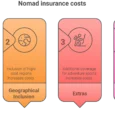For nomads travel is freedom: crossing time zones with a laptop and a carry-on, chasing Wi-Fi and wanderlust in equal measure. But freedom can unravel fast when a trip falls apart hours before take-off. Flights, visa runs, coworking deposits—none of it is cheap, especially when nomads traveling on lean budgets are already paying for nomad healthcare or a separate expat health insurance plan. Trip cancellation insurance promises to refund prepaid costs if illness, family emergencies, or geopolitical curveballs force you to pull the plug. Is that promise worthwhile for modern digital wanderers? Let’s weigh the math, the fine print, and the lived experience.
What trip cancellation insurance actually covers
At its simplest, a policy reimburses non-refundable expenses—airfares, hotel bookings, tours, conference tickets—when you have to cancel for a covered reason. Standard triggers include sudden illness, injury (your own or an immediate family member’s), severe weather, jury duty, or your airline going bankrupt. Comprehensive plans may add “cancel for any reason” (CFAR) upgrades, but those cost extra and only refund 50–75 % of losses. Most third-party insurers say the premium lands between 3 % and 7 % of total trip cost (cntraveler.com).
For digital nomads, the kicker is that a “trip” isn’t always a tidy return-ticket package; it can be an open-jaw flight plus a month of coliving fees plus a last-minute visa appointment. That complexity makes reading policy wording critical—especially when you’re also juggling nomad health coverage or a separate travel insurance annual policy.
Why cancellations hit digital nomads harder
- Longer booking windows. To snag cheap inter-continental fares, you often reserve tickets months ahead. The longer the gap, the higher the chance life interferes.
- Layered commitments. A nomad might prepay a yoga-retreat deposit in Bali, coworking membership in Tbilisi, and an onward train across Europe. Losing all three can torch a quarter’s budget.
- Visa lotteries. Some countries now run digital-nomad visas with tight entry dates. If a family emergency calls you home one week before your embassy appointment, re-applying can cost hundreds.
- Health unknowns. Even with expat health insurance or nomad healthcare covering treatment abroad, the policy rarely refunds sunk travel costs—that’s trip cancellation territory.

Single-trip vs annual multi trip insurance
If you hop continents every few months, a one-off policy starts to feel like paying rent on each flight. That’s where an annual multi trip insurance or broader travel insurance annual policy shines. It bundles unlimited trips (each capped at, say, 30–90 days) under one umbrella premium.
Pros:
- More economical if you’ll take 3+ international legs in 12 months.
- Seamless—you don’t need to remember to buy coverage before each booking.
Cons:
- Strict per-trip duration limits. Overstay and cancellation benefits evaporate.
- You still have to list a “home” country; truly perpetual nomads without a legal residence may struggle to qualify.
The big three providers for nomads travel
| Provider | Highlights | Caveats |
|---|---|---|
| World Nomads | Longtime backpacker favorite; covers adventure sports; 24/7 assistance at world nomads phone number +1-954-334-8143 (worldnomads.com) | Premiums among the highest; Trustpilot score 3.3, criticism about slow claims (alittleadrift.com) |
| SafetyWing | Subscription model renews every 28 days; Complete plan includes trip cancellation and interruption; praised for flexible start/stop (journeyera.com) | Base Essential plan excludes cancellation; some Redditors report claim hurdles (reddit.com) |
| Staysure Expat Insurance | Tailored to UK expats; cancellation cover up to £10 000 (staysure.co.uk) | Only sells to residents of certain countries; age-banded premiums climb steeply past 70 |
Many nomads vet those options by googling world nomads review, safetywing insurance review, or staysure expat insurance before every big itinerary change.
Cost-benefit math: when the premium pays off
Imagine a €2 500 Asia-to-Europe flight plus €1 200 in Airbnb credit. At a 5 % premium, full-featured cancellation coverage costs about €185. If a stomach parasite (a too-common nomad health hazard) puts you in a Thai hospital two days pre-departure, you’d recover €3 700—an ROI of 1 900 %. Suddenly that premium looks small.
By contrast, slow-mad backpackers who snag €40 regional flights and book lodging last-minute have fewer prepaid stakes. They might self-insure—set aside a rainy-day fund instead of paying for each itinerary. The rule of thumb: if losing prepaid costs would seriously dent your runway, insure it.
Hidden exclusions that ambush nomad healthcare scenarios
Hidden exclusions can feel like trip-wires in the policy small print—harmless until you try to file a claim and discover why seasoned nomads describe them as “silent ambushes.” The most common trap is the pre-existing–condition clause. Even if your nomad healthcare plan covers treatment for that old knee injury or mild asthma, a separate trip-cancellation rider can refuse to refund prepaid flights the moment a doctor’s note hints the problem existed before you bought the policy. Insurers argue they’re guarding against moral hazard; to you, it feels like paying twice and still coming up empty-handed.
Government travel advisories are another minefield. Let’s say you’re coworking in Tbilisi and have already booked a non-refundable surf retreat in Sri Lanka. Two weeks before departure, the UK Foreign Office or US State Department raises its warning level after civil-unrest flare-ups. If your policy’s fine print excludes cancellations triggered by new advisories—and many do unless you purchased an upgrade—your only choices are to risk the trip, lose the money, or wage a lengthy appeal that rarely ends in your favor.
Work-related conflicts catch remote freelancers off guard as well. Losing a major client, getting summoned to an emergency product launch, or being asked to pivot to a new time-zone-critical project rarely counts as a “covered reason,” even though the income hit is equivalent to a traditional employee’s layoff (which sometimes is covered). Digital work is simply not yet baked into legacy policy language, leaving nomads traveling for business with a frustrating gap.
The “change-of-mind” exclusion feels obvious on the surface—insurers won’t pay because you suddenly prefer Lisbon’s vibe to Chiang Mai’s. But in real life the line blurs. Perhaps your landlord in Bangkok delays essential repairs and the apartment becomes unlivable, or a series of rolling blackouts torpedoes your delivery deadlines. Unless the situation escalates into an official health or safety hazard, filing under change-of-mind is a dead end unless you sprang for a costly Cancel-For-Any-Reason add-on, which only reimburses 50–75 percent.
Finally, adventure-sports mishaps lurk in the shadows of marketing brochures packed with images of nomads cliff-diving or paragliding. Standard trip-cancellation benefits often exclude injuries sustained while kite-surfing, trekking above 4 000 meters, or even riding a scooter without a local motorcycle license. The irony is painful: the very experiences that make full-time travel worthwhile can invalidate the protection you thought you had. World Nomads’ higher-tier plan or SafetyWing’s sports package may plug some of these gaps, but without those specific add-ons a fractured wrist from downhill mountain-biking can leave you paying for both the hospital bills and the lost flights out of pocket—even if your primary expat health insurance covers the medical side.
Understanding these hidden exclusions isn’t about reading legalese for fun; it’s about safeguarding the runway that lets you keep coding on a beach or launching a startup from a café without a financial cliff in sight. Whenever you pair trip-cancellation with broader nomad health coverage, zoom in on the definitions of illness, advisory, employment, personal choice, and high-risk activities. If any of those terms sound vague, assume they’ll be interpreted against you when the stakes are highest, and budget either for an upgrade or a robust self-insurance fund.
Claiming 101—speed matters
- Notify fast. Call the provider’s emergency line (e.g., world nomads phone number above) as soon as your doctor says “unfit to travel.”
- Get paperwork. Airlines’ cancellation emails, medical certificates, police reports for stolen passports—they’re your evidence.
- Keep receipts. Every deposit and exchange-rate charge supports your claim.
- Follow up. Upload docs via the portal; many “slow pay” horror stories stem from missing forms rather than willful delays.

Real-life scenarios from safetywing insurance review threads
- A couple on SafetyWing’s Complete plan canceled a Nepal trek after one partner fractured an ankle; flights and prepaid guide fees were reimbursed (journeyera.com).
- Conversely, a Reddit user saw a claim denied for a 12-hour flight delay because they filed after booking a new ticket rather than before (reddit.com). Lesson: read timing clauses.
The edge cases: pandemics, political unrest, airline strikes
COVID-19 pushed insurers to clarify coverage. Many now list pandemics under “named events”; if a new outbreak cancels flights, you may be covered only if you bought before the event was “foreseeable.” Political unrest is similar—SafetyWing reimburses under “trip interruption” once a government orders evacuation (journeyera.com). Strikes? Covered only when announced after you purchased the policy.
Annual vs rolling subscription—choosing the right format
| Your travel style | Better fit |
|---|---|
| Nomad hub-hopping across three continents, 4-week stints | Rolling 28-day SafetyWing subscription |
| Frequent shuttle between EU base and Asian projects | Annual multi trip insurance from Staysure or Seven Corners |
| One-off sabbatical with fixed RTW ticket | Single-trip comprehensive (World Nomads Standard/Explorer) |
The broader your logistics, the more you lean toward an annual multi trip insurance. But remember: that doesn’t replace nomad healthcare for long-term illnesses.
Integrating trip cancellation with nomad health plans
Digital workers sometimes duplicate coverage: buying nomad healthcare for medical bills and a separate cancellation policy for refunds. Integrated packages such as SafetyWing’s Complete blend both. Some choose to pair a lean medical-only plan with a credit-card cancellation benefit; but issuer caps (often US $1 500) rarely cover an inter-continental itinerary.
Frequently asked questions
Does trip cancellation cover remote-job loss?
No. Employment or client income changes are typically excluded.
Can I claim if my coworking space shuts down?
Only if your policy lists “financial default of accommodation provider,” and most do not.
Is CFAR worth it for digital nomads?
CFAR premiums are 40–50 % higher, but they add flexibility for visa rejections or sudden plan pivots—common problems when nomads traveling on short notice.
What about gear?
Cancellation doesn’t insure laptops; that falls under baggage or nomad health add-ons. World Nomads covers electronics only to set limits; travelers with high-end rigs often buy separate gadget policies.
Key take-aways—when it’s worth it
- High upfront costs? Yes—protect them.
- Low prepaid stakes + high schedule flexibility? Maybe self-insure.
- Tight cash flow? Insurance beats wiping out your emergency fund.
- Complex visas or remote regions? Cancellations get pricier; insure.
- Existing coverage? Audit your travel insurance annual policy; don’t double-pay.
Conclusion – an informed “yes, usually”
Trip cancellation insurance isn’t glamorous. It won’t spice up your Instagram feed or help optimize your tax residency. Yet when a family emergency drags you off the digital-nomad trail, that modest premium can refund months of earnings. For budget backpackers bouncing between cheap hostel beds, skipping it can make sense. But for most modern nomads travel now involves pre-booked Airbnbs, coworking passes, and longer-haul flights—losses that cripple a budget.
Combine an annual multi trip insurance (or rolling plan) with scalable nomad healthcare, read the exclusions twice, and stash the world nomads phone number or Staysure hotline in your phone. Keep receipts, file fast, and you’ll convert a worst-case scenario into a reimbursed hiccup. Most importantly, the mental clarity you gain lets you focus on code pushes, client calls, or sunrise drone shots—exactly why you embraced the roaming life in the first place.




